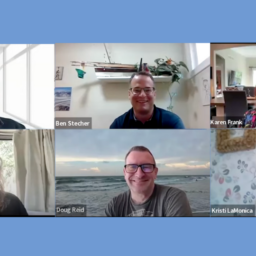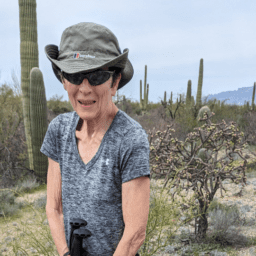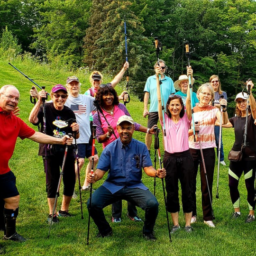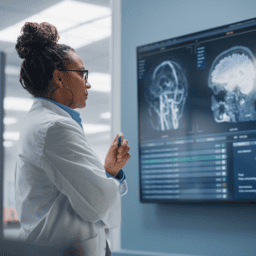Written by Amy Carlson, Davis Phinney Foundation Ambassador
I was never a dancer. A klutz? Yes. A dancer, No. And then…Parkinson’s.
In the very beginning, I could ignore the fact that I was a person with Parkinson’s, so I did. But somewhere along the way, my body and my brain moved into what I call the “ability margin,” and I had to answer the call whether I was ready or not. It was not something I wanted; I was in the middle of a career, raising a family, loving the life I had. Parkinson’s was not in the plan.
And then, to add insult to injury, I learned that I needed to exercise. No thanks! It’s not that I wasn’t an active person. At the time, there wasn’t a double black diamond run that I wouldn’t try, but I didn’t think of skiing, snowboarding, waterskiing, or hiking as exercise. Those were fun things. The word “exercise” recalled images of being pelted with balls in a gym class dodgeball game. Or maybe being struck out at the plate yet again during softball in middle school.
In a fit of compliance with physician’s orders, I went to a Zumba class. There was my 40-something self, looking past a bunch of spandex-clad 20-somethings to see my Parkinson’s body in the mirrors of a dance studio. I watched in something akin to horror as I saw, perhaps for the first time, what Parkinson’s had done to my brain and body. The right side of my body moved in time with the music. The left side of my body lurched in some sort of damp shallow echo of my right side. I left the class in tears. Exercise was evil.
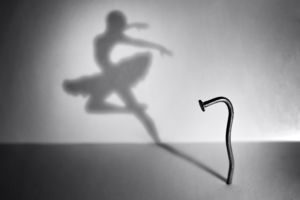
Then I was coerced (bullied) by a persistent person with Parkinson’s named Trish to attend a Dance for PD class in Pasadena. Begrudgingly, I walked in from the bright sunlight to the draped high ceiling dance studio. Around the room were people my age (40s) or older and a young woman with a few discrete tattoos clad in what I would come to understand is true dancer attire: her uniform included an overlarge David Bowie concert tee-shirt, well-loved turquoise leggings, and thick black socks. She welcomed us into a circle of chairs in the middle of the room. There were no mirrors. The eight dancers, all older than me except for my daughter who sat by my side, watched her reach for the ceiling. Then we did too.
In that class and the hundreds of hours I’ve spent studying dance since that day, I have come to learn one thing about dance:
Dance = Sound + Movement
Whether that sound is Bach or The Beatles or Beat Poetry or the beat of a single drum and whether that movement is choreographed or organic or just a body walking down the street. If sounds encourage a body to move, that body is dancing.
 I believe that dance has given me access to movement in a way that eludes the damage done in my brain by Parkinson’s. It feels as if there is another language at my disposal to send messages of movement to my body, a space in my brain that has a newer relationship with my muscles. At first, dance was intoxicating because I could escape Parkinson’s in the dance studio. I could get so far into the dance that my Parkinson’s disappeared. Later I found ways to exorcise the demon dyskinesia via dance. By letting the odd movements flow and move with my willed movements, I found that a unique and compelling choreography came to the fore. Now, I find that even in my most OFF states, I can coax my dancer muscles to life just enough to overpower my brain’s conviction of immobility and initiate movement. So far, dance is agile enough to move me alongside my Parkinson’s.
I believe that dance has given me access to movement in a way that eludes the damage done in my brain by Parkinson’s. It feels as if there is another language at my disposal to send messages of movement to my body, a space in my brain that has a newer relationship with my muscles. At first, dance was intoxicating because I could escape Parkinson’s in the dance studio. I could get so far into the dance that my Parkinson’s disappeared. Later I found ways to exorcise the demon dyskinesia via dance. By letting the odd movements flow and move with my willed movements, I found that a unique and compelling choreography came to the fore. Now, I find that even in my most OFF states, I can coax my dancer muscles to life just enough to overpower my brain’s conviction of immobility and initiate movement. So far, dance is agile enough to move me alongside my Parkinson’s.
I know that my body is more flexible, strong, and supple than it has ever been in my adult life. Pulled muscles, sprains, and strains are a thing of the past. Now, my muscles are tuned and responsive to my needs. The stiffness and ache that used to come in the days after an overzealous physical outing are over. My body welcomes a good workout.
My state of mind is revived by the release of emotion that comes through movement. The expression of pain, anger, and frustration, or the exploration of joy, exuberance, and tranquility through my core, limbs, and extremities, gives freedom to the paradoxical feelings that Parkinson’s spurs.
The cognitive challenge of dance requires my prefrontal cortex to utilize executive function. My mind plans and executes movement, organizes and remembers choreography, and translates everything into motion both purposefully and automatically.
For me, dance has been the perfect companion to take me through my journey with Parkinson’s.
Parkinson’s permits you to rock your world. Parkinson’s is an invitation to change. Flip the script. Change the way you live your life. Find a movement you like, learn to love it, and permit yourself to take time for that movement every day.

Explore More Resources about Dance and Parkinson’s
Living Well with Parkinson’s through Dance and Movement
Dance for Parkinson’s: More than Just Exercise
Moments of Victory®-Amy Carlson Squeezes All the Good out of Parkinson’s



